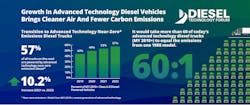Research shows the number of new near-zero emission diesel trucks on the road increased 10.2 percent between 2021 and 2022 according to the Diesel Technology Forum (DTF).
Near-zero emission trucks are advanced diesel technology manufactured in the 2010 and later model years.
According to DTF’s analysis of S&P Global Mobility TIPNet Vehicles in Operation Data as of December 2022:
• Diesel dominates the trucking sector: For the largest commercial trucks (Class 8) in operation that are 2010 or later model years, 95.4 percent are advanced diesel technology; 2.1 percent are CNG, 0.3 percent are electric, and the remainder are gasoline or other fuels.
For the entire (Class 3-8) commercial truck population of over 15 million vehicles, 75.6 percent are powered by diesel, gasoline (22.9 percent), compressed natural gas (0.46 percent), other (ethanol, fuel cell, LNG, propane, 0.85 percent) and electric (0.09 percent).
Illinois is the state with the fastest-growing registration of new advanced diesel technology Class 8 commercial trucks, up 4.6 percent as of December 2022 as compared to 2021.
• The population of near-zero emissions diesel technology trucks is growing. They comprise 57 percent of all commercial diesel trucks (Class 3-8) on the roads today. These trucks are equipped with particulate filters and selective catalytic reduction systems (SCR) that achieve near-zero levels of emissions. That’s a 10.2 percent increase in one year (2022 vs. 2021).
• 65.7 percent of all commercial diesel trucks (Class 3-8) on the road are 2007 and newer and are equipped with particulate filters so they achieve near-zero emissions for particulates.
• Indiana ranks first of the states for the highest percentage of registrations of 2010 and later model year near-zero emission diesel trucks (73.2 percent). Next in the rankings is Utah (66.2 percent), Pennsylvania (66.0 percent), the District of Columbia (65.4 percent), Texas (63.6 percent), Oklahoma (62.6 percent), Florida (62.3 percent), Illinois (60.6 percent), Louisiana (59.2 percent), and Wisconsin (59.1 percent). California lags the national average, taking the 35th spot (51.6 percent).
• There are 125 times more new generation advanced diesel trucks on the road in California than electric trucks.
“Nearly 7-million new-technology diesel trucks are on the roads, delivering our goods and services with near-zero emissions,” says Allen Schaeffer, executive director of the Forum. “Nationwide, for every electric commercial truck on the road, there are nearly 1,100 powered by internal combustion engines.”
“According to this most recent analysis, internal combustion engines (diesel, gasoline, natural gas, and propane) power about 99.91 percent of the nation’s trucking fleet. As the trucking industry explores new fuels, including all electric and fuel cell technology, it is clear that diesel and other internal combustion engines are going to continue to play a dominant role for years to come,” he says.
Diesel technology has fundamentally transformed over the last decade, with advancements leading to achieving near-zero emissions beginning with the 2010 model year. Its continued dominance in trucking reflects diesel’s record of continuous improvement and low-cost operation. And now we can see the next milestone for advanced diesel technology emerging in California in 2024 and other parts of the country in 2027. That next generation of diesel will further reduce NOx emissions by an additional 50 to 80 percent over current models.
Source: Diesel Technology Forum
About the Author
Frank Raczon
Raczon’s writing career spans nearly 25 years, including magazine publishing and public relations work with some of the industry’s major equipment manufacturers. He has won numerous awards in his career, including nods from the Construction Writers Association, the Association of Equipment Manufacturers, and BtoB magazine. He is responsible for the magazine's Buying Files.

